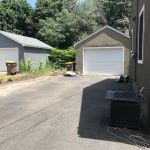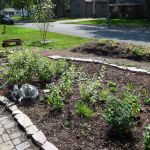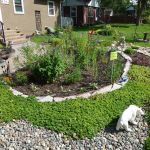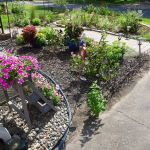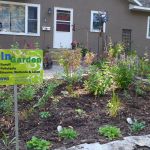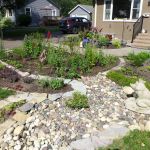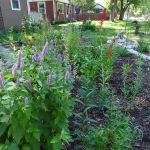Neighborhood Spotlight: Ingrid
Ingrid applied for a VLAWMO Soil Health Grant in 2021 and finished it off in 2022. Having a pre-existing cobblestone walkway, she blended the raingarden in with a slick stone border. The outer border of the raingarden includes a creeping sedum groundcover for a transition between the raingarden, a rock bed, and a new bee lawn. The former lawn was hit hard by the sun, and the bee lawn has shown to be a more effective, low maintenance cover that stays green where conventional turf struggled. The raingarden takes rooftop runoff and uses an underground pop-up feature, routing the water from the downspout, beneath the sidewalk, and into the center of the raingarden basin. The raingarden is placed more than 10’ away from the home foundation, which is a raingarden standard to ensure the water infiltrates away from the basement. An extra advantage of routing the runoff beneath the downspout is that winter maintenance is greatly reduced on the sidewalk due to the lack of snowmelt and ice formation now occurring on the sidewalk.
While Ingrid was working on her raingarden, a neighbor just across the street was also starting up a raingarden supported by a VLAWMO grant. Together they compared notes, shared strategies, and built a neighborly comradery that continues to today.
What motivated you to go in this direction for your yard?
I wanted to improve my front yard drainage and this looked like a good option. Previous drainage was tricky because of inadequate soil grading combined with the downspout directing flow right to the front of the house to that spot. I was also motivated by the grant that was provided.
How would you describe your creative design process – was it a big vision or pieced together as you went along?
I read a few of books about rain gardens and did some research online. It ended up being pieced together. I hired a landscaping expert for just a consult and also got a lot of help from the team at VLAWMO. I completed the work myself over the course of 3 months.
How did the raingarden blend into your existing yard and drainage set-up?
My front yard needed some work on the entry path and I was able to incorporate the rain garden into the existing stone design. It made a big improvement on the look of my front yard. I also planted a portion of my front lawn with a Bee lawn. The excavated soil from the raingarden basin had sat in the yard for a time, killing off the front yard turf. I made this part of my strategy however, because it allowed me to plant a fresh new bee lawn. Some raingardens keep the soil on-site to create a berm, but I thought keeping the front yard flatter would help with maintenance such as the occasional mowing of the bee lawn. I also had the existing stone path that I didn’t want to disturb.
Has the raingarden inspired any other similar projects?
I ended up doing another grant through Lawns to Legumes for a pollinator garden in my backyard.
How has the raingarden changed your interaction with your yard? Any favorite sightings or things you’ve noticed?
It made being in my front yard more enjoyable, and it’s great to look at. I enjoy seeing the bees and butterflies hover about my plants.
Any advice for other folks who may be interested in a raingarden or groundcover?
Just go for it. It seems intimidating at first but it's all easily navigated and the support from VLAWMO staff and other VLAWMO grant recipients were super helpful. It doesn't have to be expensive, and shared plants are often available on marketplace.

